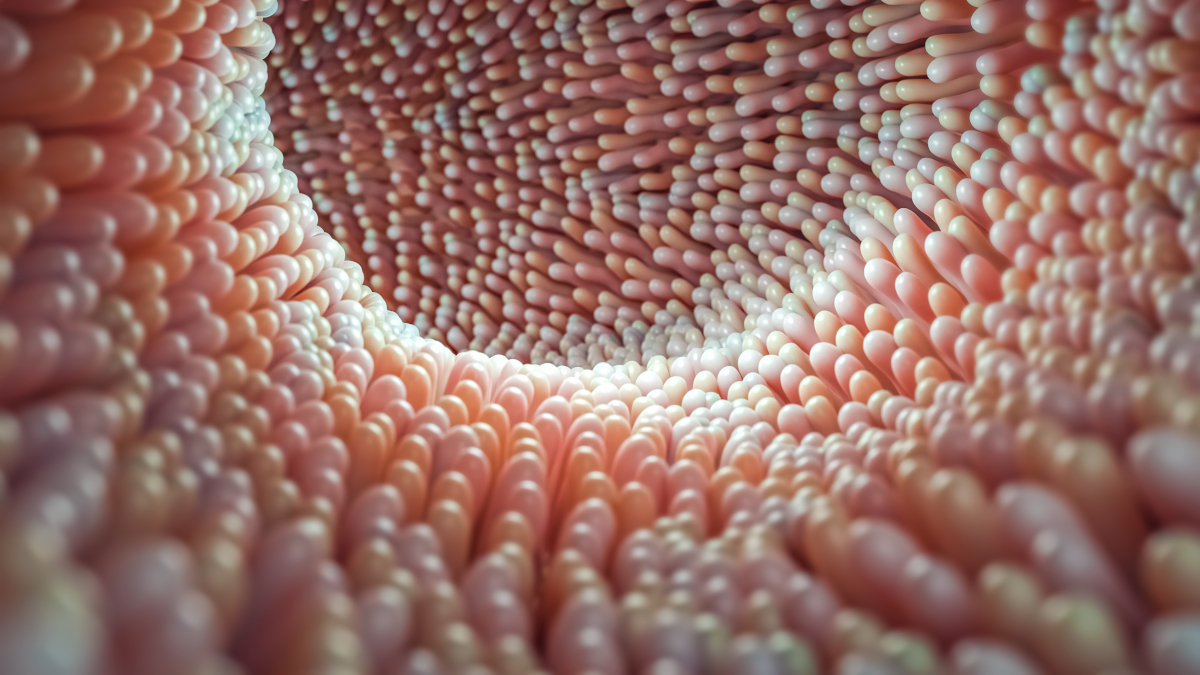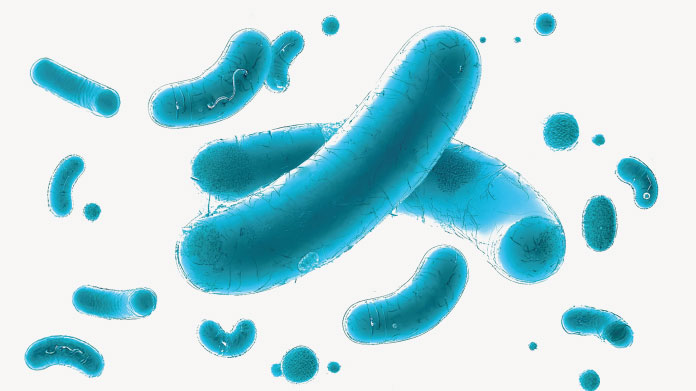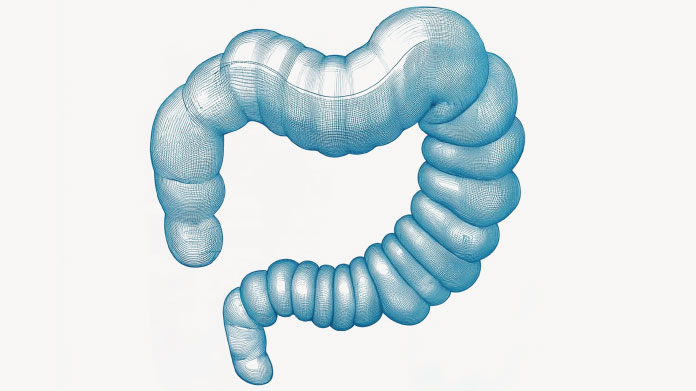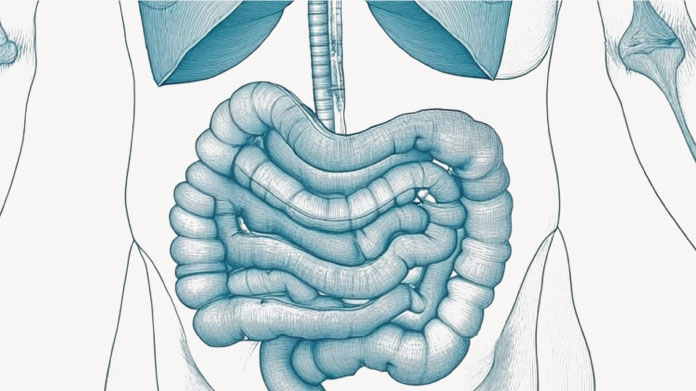Is there a ticking time bomb in your gut?
A poorly-maintained digestive tract, populated with opportunistic pathogenic bacteria and fungi (particularly Candida albicans), and polluted with badly-digested food, is at risk of becoming blocked by disgusting and toxic faecal matter. This phenomenon is a factor in health imbalances and problems of varying degrees of seriousness.

In particular, it can lead to persistent constipation, bloating, diarrhoea, inflammation of various kinds, eczema, mood swings or conditions such as irritable bowel syndrome, bloody diarrhoea or even cancer of the colon. Autopsies often show the deceased person’s colon to be heavily blocked by excrement. Hence the saying: “death begins in the colon...”. An unclean intestine increases the risk of poor immunity because intestinal flora normally act as a protective barrier against foreign bodies. As a result, you may be more susceptible to infection and inflammatory diseases which can affect the digestive, respiratory and urogenital systems, etc …
In addition, a ‘sickly’ colon can also give rise to emotional problems : few people, even doctors, know that 80% of the serotonin (the ‘happiness’ hormone) found in our bodies is produced by cells in the intestines. In some ways, the intestine can be thought of as the « second brain » and it deserves the best possible care.
Maintaining your digestive tract
The Internet is full of offers, some more genuine than others, aimed at cleaning your digestive tract. But the intestine is not a chimney that needs sweeping or a pipe that needs unblocking by Dynorod! Not only is it more delicate, but it is also much simpler. Normally, no intervention is required as Mother Nature has taken care of everything: an army of billions of microorganisms populate the colon (the final part of the intestine, immediately befre the rectum), protecting and cleansing it day and night, and by colonising the site, they prevent baocteria and yeast from doing so.
At 100,000 billion, there are 100 times more of these microbes than there are cells in the body. This huge army is known as « intestinal flora » or « microbiota ». The word « flora » may seem a surprising choice for such an environment but it is a reference to the large number of species of bacteria and yeast (at least 200) that co-exist in the colon, just like in a botanical garden.
It is up to each one of us to maintain this garden, re-seed and weed it regularly, and feed it with fertiliser … or we can choose to neglect it. In the latter case, the beautiful landscaped garden can quickly turn into a disgusting, smelly dump which will provide shelter for harmful, disease-provoking pests.
Bad smells are not normal
The colon’s main function is to ferment partly-digested food in order to extract the last nutrients and enable them to be transported into the bloodstream. A healthy, properly-functioning colon leaves behind only unusable waste products which are regularly evacuated and have no unpleasant odour. In contrast, the presence of harmful bacteria and yeasts upset the transit process, leading to constipation or diarrhoea, and food residues become malodorous. Furthermore, poor digestion, apart from being unpleasant in itself, prevents optimal extraction of nutrients from food. If nothing is done to rectify this, nutritional shortfalls or deficiencies can appear.
This harmful flora also produces an abundance of carbon, methane and hydrogen gas. So much so that if you allow the situation to take hold, these germs will proliferate to the point of causing pockets of gas throughout the whole colon, until you feel as if you’re going to explode. Flatulence and bloating are no laughing matter. They are a sign that your food is poorly digested and that your colon needs help. This vicious circle is the result of a lack of good bacteria that promote proper digestion.
Your intestinal flora is determined at birth
The composition of your intestinal flora depends first and foremost on the circumstances of your birth. When you were in your mother’s womb, your digestive tract was sterile. It contained not a single microbe. It was only at the moment of delivery that the bacteria and yeasts moved in: 72 hours after your birth, your digestive tract already contained 1000 billion bacteria and yeasts!
Where did all these bacteria and yeasts come from? Very few people realise this, but for children born naturally, they come from the vaginal flora of the mother. Vaginal flora is heavily dependent on intestinal flora and thus a woman with good intestinal flora in the last few weeks of her pregnancy will pass on the right microbial species to her child to colonise its gut. If, on the other hand, the mother’s intestine is contaminated by opportunistic pathogenic species, her baby will unfortunately inherit those instead.
It has been observed that particular microflora passed on by mothers to their children at birth can create a predisposition to certain diseases. This is particularly so where there is a family history of asthma and eczema. If, in the last months before labour, the mother can regenerate her microflora (we will explain how), her child will not inherit microflora that induce eczema and/or asthma. This simple measure can thus protect the new-born from a potentially life-long condition and the prospect of suffering from chronic bronchitis and the need for incapacitating breathing assistance.
However, babies born by caesarean section also face problems. Since they are removed directly from the (sterile) placenta, babies born by caesarean section have no contact with the mother’s flora. Their first contact is with environmental flora - that of the hospital - which is often full of antibiotic-resistant bacteria, particularly the infamous Staphylococcus aureus. This exposure to ‘hospital’ intestinal flora can have nasty consequences throughout life if it is not rectified promptly.
It is therefore very important for a mother who has had a caesarean section to introduce good bacteria to her baby’s digestive tract from birth. However, even good intestinal flora at birth can subsequently become unbalanced:
How certain factors can upset the balance of your microflora
Once we leave our mother’s womb, the balance of our intestinal microflora is in a process of continual evolution. It is a dynamic equilibrium that can be upset by various endogenous and exogenous factors:
- endogenous factors or internal causes: it may be that you have an immune deficiency or are suffering from a discrete metabolic disease which can disrupt your intestinal flora. Injury or surgery, inflammation, chronic constipation or tumours in the intestine can all lead to serious upsets in microflora which will exacerbate the symptoms of your illness and delay your recovery;
- exogenous factors or external causes : an unbalanced diet, heavy metal contamination, agricultural pesticides and anti-microbial food additives, infection from pathogenic germs, intense stress, antibiotic treatment and vaccination can all play a part in inhibiting good bacteria which then provides the opportunity for pathogenic (disease-causing) germs to multiply.
Consequences can vary in severity from simple digestive problems, to a complete breakdown in the body’s defences. In the latter case, there is a risk of germs proliferating to the point of septicaemia (generalised infection) with potentially fatal results. This demonstrates just how essential a balanced intestinal flora is for good health and resistance to disease. We should do everything we can to maintain it in a healthy microbiological condition.
How to restore the balance
In order to restore the balance, you need to eliminate from your diet those foods to which you are intolerant: very often this will require diagnosis by a nutritionist but the most common intolerances are refined cereals, particularly gluten-rich wheat, and dairy products. You need to do this for three to four weeks to gauge the results. At the same time, it is essential to achieve a healthier lifestyle by upping the amount of gentle exercise you take (strenuous exercise actually aggravates inflammation), breathing better (cardiac coherence), and taking the time to eat and chew properly. To restore the integrity of the intestinal mucous membrane, you should consume more anti-inflammatory foods (nuts, omega 3-rich fish, cooked vegetables, salad and mild spices) and teas (acorus calamus, nettle, yarrow).
In most cases, it is also necessary to repopulate your intestinal flora with good probiotics.
Manufacturers’ tactics
But what constitutes a “good” probiotic?
You will find hundreds of products on the market claiming to contain probiotics but to avoid falling into certain traps, it’s important to be aware of the following. Every May, the large nutritional supplement exhibition, Vitafoods, takes place in Geneva. Fifteen or so years ago, there were only around thirty exhibitors, but today there are hundreds, from all continents of the world, offering all sorts of natural ingredients extracted from plants and animals. Each year, the exhibition, which is aimed at professionals in the dietary supplements business, presents new ingredients which are always more effective and sophisticated.
The majority are supported by clinical studies demonstrating their health efficacy and the quality of these ingredients has improved significantly over the years. But the most striking thing is that the costs of these ingredients vary hugely for the same product, depending on its origin, purity and the science behind it. Say, for example, that your doctor recommends you take calcium. Among the pharmaceutical products and dietary supplements available, you will find various forms of calcium, but at widely differing prices depending on whether it is calcium phosphate, calcium chloride, calcium sulphate, carbonate, or even citrate, glycerophosphate, gluconate or pidolate! (For information - the last three are the best for health).
This confusing picture is a real problem since neither you nor your doctor could possibly know - without poring over the scientific literature - that these various ingredients do not have same properties. The way they interact with the other nutrients you are consuming will not be the same. The effectiveness with which your body absorbs them - their bioavailability - will also vary. What’s more, manufacturers do not necessarily display the precise form of the ingredient in their product on the packaging. It may simply say ‘calcium’ and the number of grams per tablet or capsule. Certain forms are inexpensive, others relatively costly, and a less scrupulous manufacturer will happily sell you the cheaper form, maintaining it has the same effects as the more expensive forms, which is completely untrue.
The patient may therefore end up concluding that dietary supplements in general simply “don’t work” and, disappointed, will go back to u>chemical-based pharmaceuticals.
The risk with probiotic capsules and tablets
With probiotics, which are forms of living microorganisms, this risk is magnified a hundred-fold. A study in 2010 showed that the majority of commercially-available probiotics do not contain enough living bacteria to have any effect. But is this really a surprise? Many probiotics today are sold in tablet form.
However, there are very few living bacteria in tablets since the pressure needed to form the tablet requires a temperature of over 50°C, which kills a large proportion of the bacteria. It is therefore almost impossible to produce effective probiotic tablets. Some manufacturers claim to have got round this with probiotic tablets that have been protected by microencapsulation. The problem is that this disproportionately increases the volume taken up by the probiotics. To ingest the required amount (at least 1 billion) you would therefore need to take 100 tablets a day.
What about probiotics in liquid form?
Probiotic bacteria do not last very long in a fermented liquid milieu (for example, in an animal or plant milk base). The various strains present will convert the sugars and proteins in the milieu into organic acids and oxygenated water which the bacteria will be unable to withstand for very long. In addition, it is impossible to maintain a balanced blend of probiotic strains in a liquid milieu because each one evolves differently during fermentation and preservation. If we take the case of classic yogurt, which contains only two bacterial strains (Lactobacillus bulgaricus andStreptococcus thermophilus), not only are they weak probiotics to start with, but following the process of preservation, several weeks elapse between their manufacture and their arrival on your plate which severely compromises the bacteria’s survival and equilibrium; while they will be able to maintain a beneficial pH in the intestine, they will be unable to regenerate intestinal flora.
How to avoid wasting money on probiotics
People waste hundreds of pounds a year on probiotics because they take them at the wrong time, which reduces their efficacy to almost zero. If ingested at a point when the stomach is producing a lot of gastric juices (high in hydrochloric acid) in order to digest food, the probiotics will be largely destroyed by the acidity in the closed stomach.
It is therefore very important to take probiotics on an empty stomach - first thing in the morning when your stomach’s pH is close to neutral. Even more importantly, the ‘door’ which closes off your stomach (the pylorus) and which prevents food from passing into the intestine before it has been digested, is open at that moment. Taking probiotics in capsule form means they are protected in the stomach. They are released only once the contents of the capsule reach the intestine where they can exert their beneficial effects. That is why people in India drink lassi, a particular form of probiotic-rich fermented milk, before a meal.
It is also vital that the probiotics you take contain a high population of bacteria, at least 1 billion; below this level, the effect will be almost non-existent. In fact, 8 billion is preferable, in order to guarantee greater efficacy when your intestinal flora is badly upset. Remember that over the course of their journey through the digestive system, the weaker bacteria will fall victim to factors such as gastric pH and bile secretions.
Which probiotic strains should you choose?
The probiotics you take should include several different, complementary and synergistic strains with scientifically-documented effects.
Five strains in particular are able to develop in the colon, in the mucous that covers the mucous membrane, offering maximum protection and quickly restoring healthy immunity. Bifidobacterium lactis, Lactobacillus acidophilus, Lb. paracasei, Lb plantarum, and Lactococcus Lactis, are all, in the main, able to produce lactic acid that is very well metabolised. These probiotic strains also produce other substances that inhibit contamination of microflora.
You will find all these in Probio Forte capsules. Two capsules contain 16 billion bacteria, the dose for maximum efficacy.
The Bifidus issue
Some people these days are wary of probiotics due to a campaign waged against manufacturers of yogurt that contains bifidus. Researchers had noticed that the intestinal flora of obese people contained abnormally high levels of bifidobacteria (active bifidus). Stories have since been circulating on the Internet about probiotics being used in industrial farming to fatten pigs and suggesting that they would have the same effect in humans. But, as with all polemic, this is both true and false.
In fact, ‘bifidus’ type bacteria are important for infants and very young children. Studies show the intestinal flora of children with allergies to be lower in bifidobacteria than that of non-allergic children. It remains good practice to consume them occasionally up to adolescence - they provide the intestinal relief many children and adults experience when eating their first active bifidus yogurts. However, if you continue to eat these yogurts on daily basis, it may cause an imbalance in your gut flora and lead to weight gain. The same applies to sweetened fermented milk products but here it is the added sugar that is the problem since children who consume them risk irreversible weight gain.
How to take probiotics
For the first month (intensive phase) you should take 2 capsules of Probio Forte a day every morning. This is the dosage and duration necessary to regenerate intestinal microflora. After that, one capsule a day should be taken for the next two months (stabilisation phase). At this stage, most of the sources of your discomfort may already have been eradicated. One capsule every other day (maintenance phase) should then be enough to avoid any future imbalance of your microflora by the endogenous or exogenous factors described above.
The difference after six months’ supplementation can be considerable.
Also bear in mind that there are other highly-innovative probiotic formulations for tackling more specific problems.
The supplement Lactoxira, based on the latest advances in neuroscience, is aimed at anyone prone to problems with low mood and motivation (depression, seasonal affective disorder, recurrent episodes of the ‘blues’). Each capsule contains around 100 billion beneficial bacteria (Bifidobacterius longum, Lactobacillus plantarum, Bifidobacterium bifidum, Lactobacillus salivarius, etc.), which are able to secrete specific neurotransmitters and reduce the abnormally high neuro-inflammation seen in people with depression. It’s a revolutionary treatment which not only supports psychological health but also provides all the benefits normally associated with probiotics: a reduction in inflammation markers, improvements in digestive problems, enhanced digestion …
For weight control, the strain Lactobacillus gasseri is indispensable: naturally present in breast milk, it helps reduce waist-size by acting on abdominal fat. Of course it also supports digestive health and optimisation of the body’s immune system.
Finally, to tackle skin problems(acne, blackheads, redness, and oily, flaky or itchy skin,), there’s an excellent probiotic formula consisting of four specific strains plus nutrients that are scientifically-recognised for their benefits for skin health (vitamin C, vitamin E, vitamin B2, fructo-oligosaccharides). Called Derma Relief, it’s designed to improve the integrity of the intestinal barrier, modulate the skin’s immune system and reduce skin inflammation. To take it, you simply dissolve the contents of one stick sachet (which contains 3 billion lactic bacteria) in a glass of water, or swallow it straight from the sachet.
Whichever one you choose, it’s also wise over these 6 months to adopt a healthier diet, including significantly higher fibre intake, and increase your level of physical activity.
Keywords
56 Days
Very happy with the order and the…
Very happy with the order and the prompt team's response to an identified issue with my order.
KUQI Fatmir
63 Days
15 + years as a customer
I have been using their products for over 15 years as I find both the quality and pricing excellent.
Del Chandler
65 Days
Good quick delivery
Good quick delivery
Timothy O Shea
66 Days
Good service
Good communication following order. Product came within the time frame and was well packaged. The only confusing thing I found was in checking out. For some reason it is not clear how to do so and the current system should be improved.
Joe O Leary
75 Days
Simple and fast.
Simple and fast.
Nina
76 Days
Great product was definitely what is…
Great product was definitely what is says and arrived on without issue
customer
82 Days
I love reading those product facts on…
I love reading those product facts on Supersmart.com. Effective health products making permanent changes to my blood-work results and testes. However, I also have to order capsules from other websites.
NORDGULEN Olav
84 Days
Great products
Great products Very easy to choose, to order… and to get at home
Federica mastrojanni
87 Days
Service rapide et bons produits
Service rapide et bons produits
customer
88 Days
Good products and fast delivery
Good products and fast delivery
Trusted
93 Days
Does what it says on the can
I believe in this product Made to highest standard The ordering process is straightforward Delivery time prompt Excellent product, excellent service Happy customer ❤️
Sheba Kelleher
98 Days
Excellents produits
Excellents produits. Rien à dire si ce n'est qu'ils sont très chèrs.
MJS_France
100 Days
Very good supplement
Very good supplement
Glaveash
101 Days
Supersmart supplements are really…effective
Supersmart supplements are really effective and have helped me and family members and friends to improve their health including some of us with severe health problems including some with no existing medical treatment.
Anne Georget
102 Days
SuperBig Supersmart
SuperBig Supersmart
Pierre



